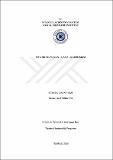Please use this identifier to cite or link to this item:
http://hdl.handle.net/11547/1391Full metadata record
| DC Field | Value | Language |
|---|---|---|
| dc.contributor.author | Türkkanı, Hasan Can | - |
| dc.date.accessioned | 2019-04-12T12:03:18Z | - |
| dc.date.available | 2019-04-12T12:03:18Z | - |
| dc.date.issued | 2018-07 | - |
| dc.identifier.uri | http://hdl.handle.net/11547/1391 | - |
| dc.description.abstract | ÖZET Bir oyunu sahneye koyma işi olan reji, tiyatro tarihi boyunca çok farklı biçimlerde ele alınmıştır. Biçimdeki bu farklılık, sahneye koyulan oyun türlerinin dönemlere göre değişkenlik göstermesinden kaynaklandığı gibi oyunun sahnelendiği yer olan tiyatro mekânının ve bu mekânla beraber ortaya çıkan uzamın değişip dönüşmesinden de kaynaklanmıştır. Böylece tiyatro tarihinin başlangıcından bu yana değişen, dönüşen ve gelişen bir mekân-uzam-reji ilişkisi ortaya çıkmıştır. Yönetmenin ortaya çıkışından önce reji, dramatik metne bağlı olarak, daha çok yazınsal bir uygulama ya da metni direkt sahneye aktarma, metni sahnenin hazır kalıplarına sokma olarak süregelmiştir. Genel bir ifadeyle, yazılmış olan metin sadece sahnede somutlaştırılmıştır. Bu hazır kalıplarına sokma işleminden, önceleri oyun yazarları sonraları ise rejisörler sorumlu olmuştur. Yönetmenlik kavramının ortaya çıkışıyla uzamın etkinlik kazanması sonucunda klasik sahne uzamının yapısı çeşitlenmiş, uzamın dikeylik, yataylık, derinlik gibi boyutlarının araştırılıp kullanılmasıyla, sahnenin merkeziyetçiliği kırılmıştır. Tüm bunların sonucu olarak seyirci tarafından sahneye yöneltilen geleneksel bakış kırılmış, seyirciyi oyun alanında gezinmeye itilmiştir. Kutu sahnenin dışına taşan, çeşitli yapılarda, alanlarda, her yerde gerçekleştirilmeye başlanan tiyatroyla birlikte, seyirci de kutu sahnenin sınırlarını aşmış, tek yönlü bakış açısının yerini çok yönlülük almıştır. İtalyan sahnenin perspektife dayalı düz uzamının daha üç boyutlu bir uzama dönüşmesiyle sahnede gösterilen yerden, ortama geçiş sağlanmıştır ve kutu içinden bir türlü çıkamayan İtalyan sahnesi egemenliği, sahneleme düşüncesinin değişime uğramasıyla bozulmaya başlamıştır. Gerek sahnelenmiş bir tiyatro oyununu incelemek için gerekse yönetmen olarak yeni bir oyun sahnelemek için mekân ve uzamın oyun yeri ile olan ilişkisini inceleyip anlamak gerekmektedir. Bu gereklilik, bir ilişki dizgesi yaratarak, “Tiyatroda Mekan – Uzam – Reji İlişkisi” başlığı altında bir araştırma yapma gerekliliği doğurmuştur. | tr_TR |
| dc.language.iso | tr | tr_TR |
| dc.publisher | İSTANBUL AYDIN ÜNİVERSİTESİ SOSYAL BİLİMLERİ ENSTİTÜSÜ | tr_TR |
| dc.subject | Mekân | tr_TR |
| dc.subject | Uzam | tr_TR |
| dc.subject | Reji | tr_TR |
| dc.subject | Tiyatro Tarihi | tr_TR |
| dc.subject | Tiyatro Yönetmeni | tr_TR |
| dc.subject | Place | tr_TR |
| dc.subject | Space | tr_TR |
| dc.subject | Satage Management | tr_TR |
| dc.subject | History of Theatre | tr_TR |
| dc.subject | Theatre Director | tr_TR |
| dc.title | TİYATRODA MEKAN – UZAM – REJİ İLİŞKİSİ | tr_TR |
| dc.type | Thesis | tr_TR |
| dc.description.abstractol | ABSTRACT Stage management, which is a job of putting a theater play on stage, has been handled very differently, throughout the history of theater. This difference in form, also arises from the fact that the types of the theatre plays put on the scene, vary from the period of time, as well as from the space of theater that theatre play is staged, and the extent of the space that emerges with this space. Thus, since the beginning of the history of theater, a changing and evolving relationship of place, space and stage management was emerged Prior to the appearance of the director, the stage management, as a result of a dramatic text, has been accepted more as a literary practice, putting the text directly to the stage and following the same pattern of the text for the stage was the usual method. In general, the written text is only embodied in the scene. In the beginning, The playwriters were responsible from this process. Afterwards, the responsibility was taken by the stage managers. With the emergence of the concept of directing, the structure of the classical stage space has been diversified as a result of the activity of the space, and the centralization of the stage has been broken by exploring the dimensions such as verticality, horizontality and the depth of space. As a result of all of this progress, the traditional view that pointed to the stage by the spectator was broken, and the audience was pushed into the playground. With the starting of the new perspectives, the audience has crossed the boundaries of the box scene, and versatility has become dominant. The perspective of the italian scene that based on flat space turned into three dimensional space, and the transition from place to the place that shown in the scene was provided. The Italian sovereignty, which was still trapped in the box, has begun to deteriorate with the change of the staging idea. In order to examine a staged theatrical play, it is necessary to examine and understand the relationship between the space and the location of the space, in order to stage a new play as a director. This necessity has created the necessity of conducting a research under the title of place, space and stage management. | tr_TR |
| Appears in Collections: | Tezler -Thesis | |
Files in This Item:
| File | Description | Size | Format | |
|---|---|---|---|---|
| TİYATRODA MEKAN – UZAM – REJİ İLİŞKİSİ.pdf | Yüksek Lisans Tez Dosyası | 7.76 MB | Adobe PDF |  View/Open |
Items in DSpace are protected by copyright, with all rights reserved, unless otherwise indicated.
